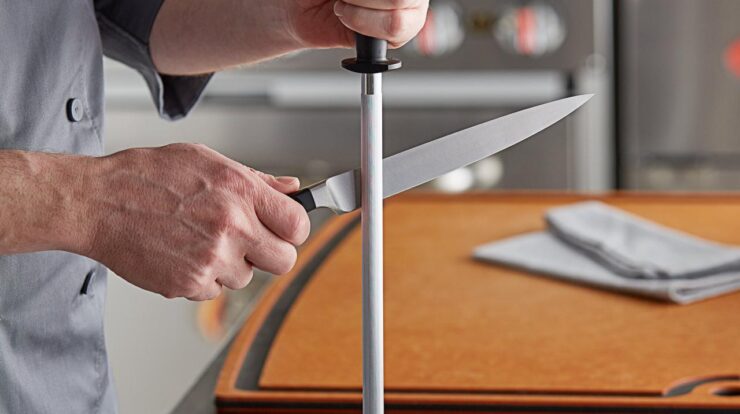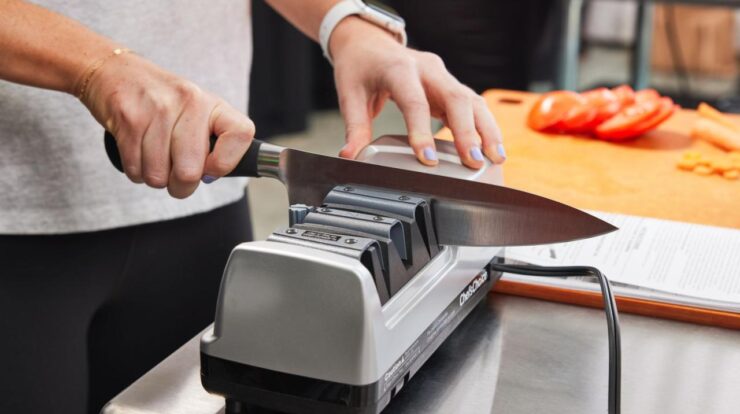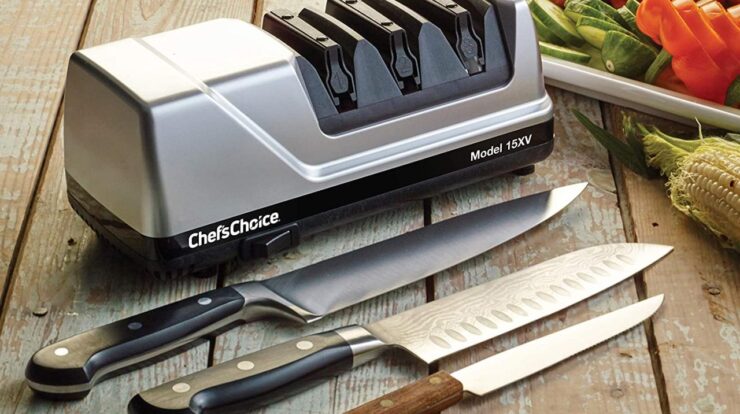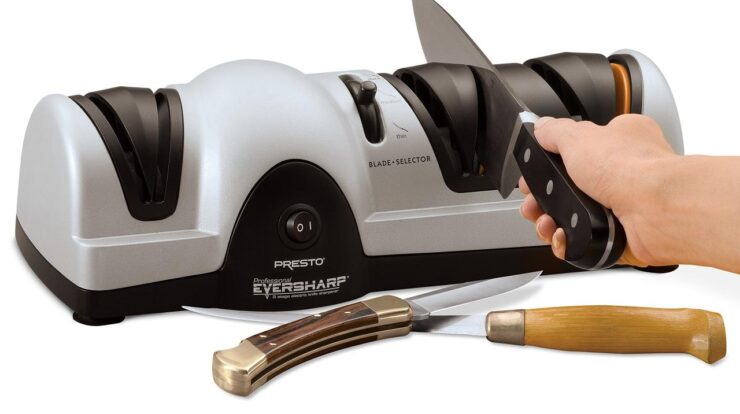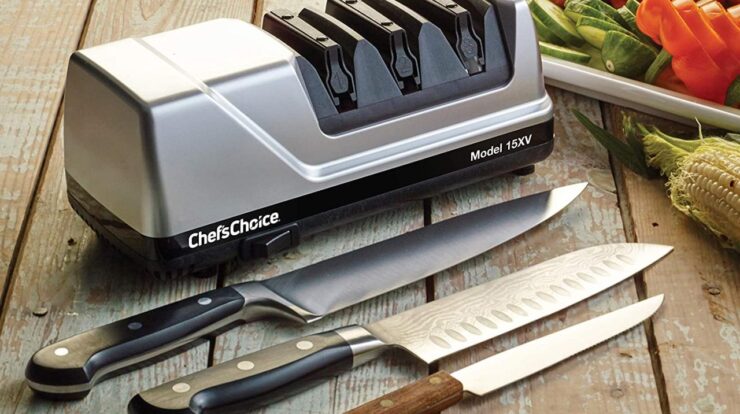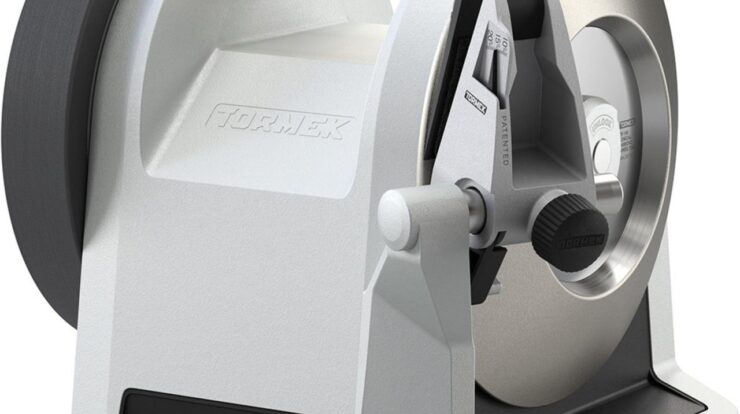In the world of culinary arts, sharp knives are an essential tool. And when it comes to sharpening knives, electric knife sharpeners offer a convenient and effective solution. In this comprehensive guide, we’ll delve into the world of electric knife sharpeners, exploring their features, benefits, and how to use them like a pro.
Electric knife sharpeners are designed to make knife sharpening a breeze. They use rotating abrasives or grinding wheels to quickly and evenly sharpen knives, saving you time and effort compared to manual sharpening methods.
Electric Knife Sharpener Overview
Electric knife sharpeners are motorized devices designed to sharpen the blades of knives. They offer a convenient and efficient way to keep knives sharp and ready to use.Electric knife sharpeners are beneficial because they:
- Save time and effort compared to manual sharpening methods.
- Provide consistent and precise sharpening results.
- Can sharpen a wide range of knife types, including serrated blades.
Types of Electric Knife Sharpeners
There are two main types of electric knife sharpeners:
Pull-through sharpeners
Knives are drawn through a series of sharpening slots, each with a different abrasive material.
Sharpening stones
Knives are held against rotating sharpening stones, which grind away metal to create a sharp edge.
Features and Functionality
Electric knife sharpeners offer various features to enhance the sharpening process and ensure optimal results. They typically include:
- Adjustable Sharpening Angles:Electric knife sharpeners allow users to select the desired sharpening angle based on the type of knife and the desired level of sharpness.
- Variable Speeds:Some models offer variable speeds, enabling users to adjust the sharpening speed according to the hardness of the knife blade.
- Built-in Guides:Most electric knife sharpeners feature built-in guides that help maintain the correct angle and pressure during sharpening.
- Safety Features:Electric knife sharpeners often incorporate safety features such as non-slip bases and finger guards to prevent accidents.
How Electric Knife Sharpeners Work
Electric knife sharpeners employ a rotating abrasive wheel or belt to remove metal from the knife blade. The abrasive surface creates a new cutting edge by grinding away the dull or damaged metal. The adjustable sharpening angles and speeds allow users to customize the sharpening process to suit different types of knives and desired sharpness levels.
Sharpening Angles and Speeds
The optimal sharpening angle depends on the type of knife and its intended use. Generally, kitchen knives require a sharper angle (around 15-20 degrees) for precise cutting, while outdoor knives benefit from a wider angle (around 25-30 degrees) for durability.
Electric knife sharpeners typically offer a range of sharpening angles to accommodate various knife types.Variable speeds allow users to adjust the sharpening speed based on the hardness of the knife blade. Harder blades require slower speeds to prevent overheating and damage to the blade.
Softer blades can be sharpened at higher speeds for faster results.
Usage and Maintenance
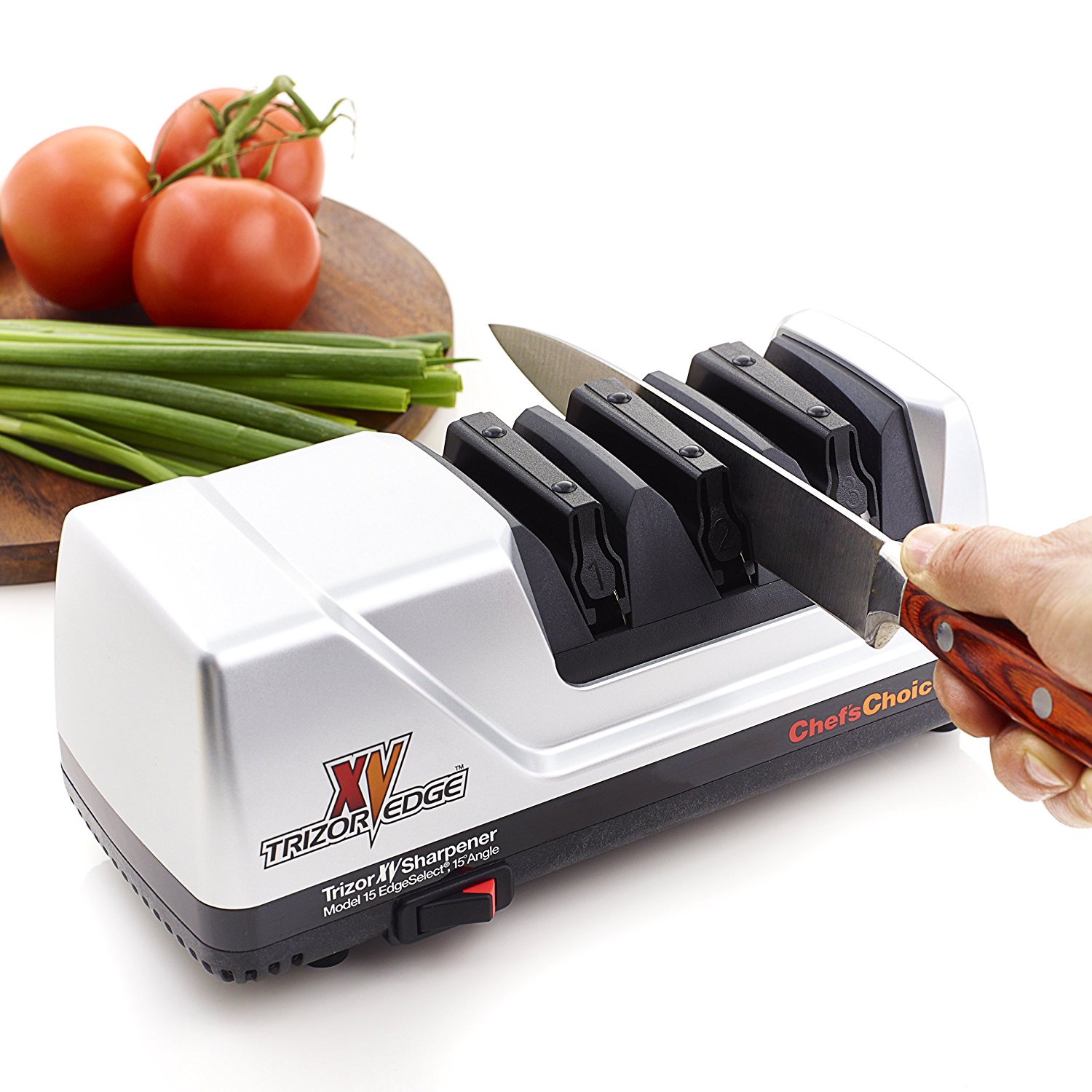
Using an electric knife sharpener is a convenient way to keep your knives sharp and in good condition. Here are some tips on how to use and maintain your electric knife sharpener:
How to Use an Electric Knife Sharpener
- Insert the knife into the sharpening slot.
- Turn on the sharpener and slowly draw the knife through the slot.
- Repeat steps 1 and 2 until the knife is sharp.
How to Maintain and Clean an Electric Knife Sharpener
- Unplug the sharpener before cleaning.
- Wipe down the exterior of the sharpener with a damp cloth.
- Lubricate the sharpening slots with a few drops of oil.
li>Use a small brush to clean out the sharpening slots.
Safety Precautions, Electric knife sharpener
- Keep your hands away from the sharpening slots while the sharpener is in use.
- Do not use the sharpener on knives that are too dull or damaged.
- Always unplug the sharpener before storing it.
Comparison with Other Sharpening Methods
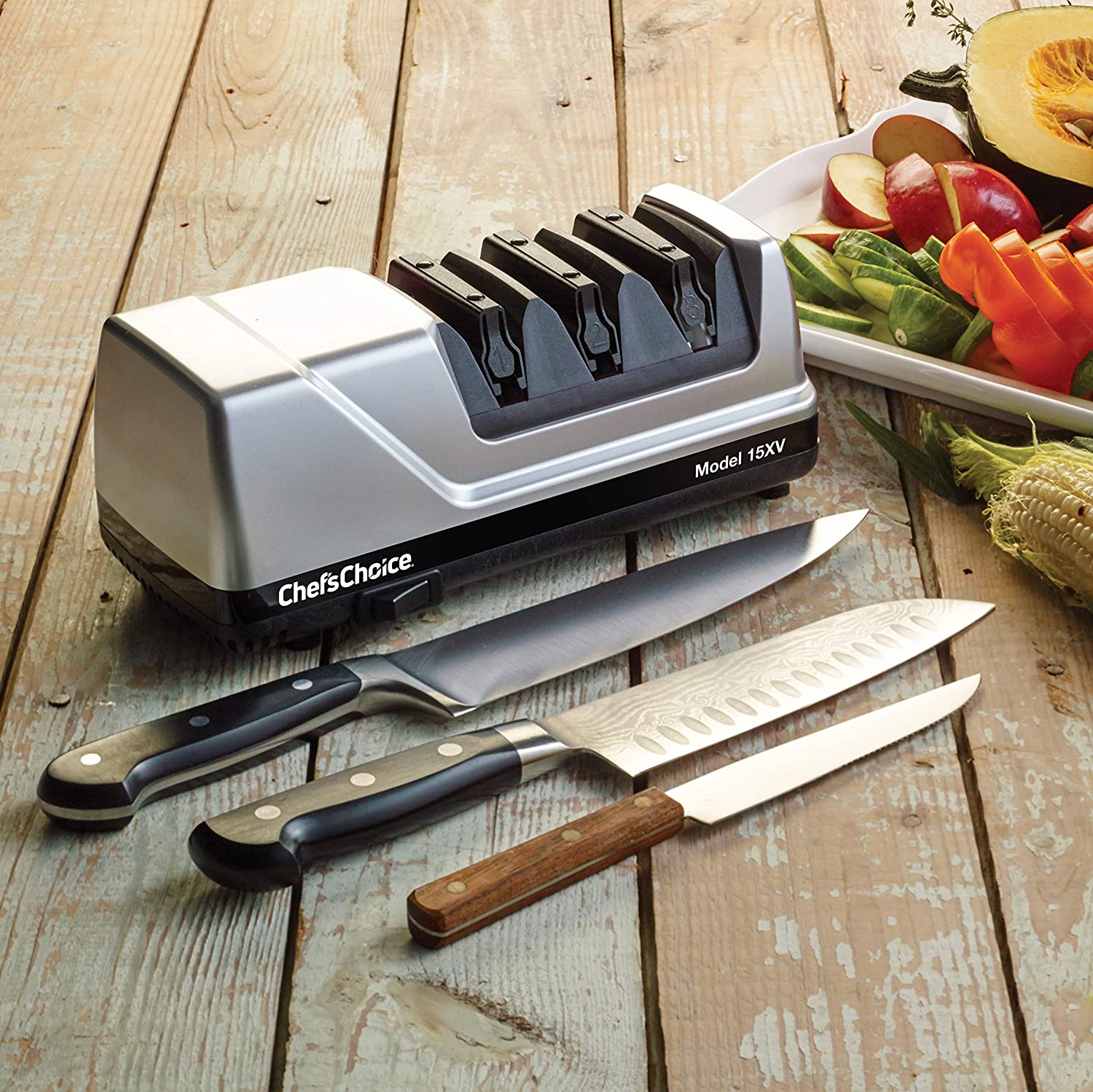
Electric knife sharpeners offer several advantages and disadvantages compared to manual knife sharpeners. Understanding these differences can help you choose the best method for your needs.
Electric Knife Sharpeners
- Convenience:Electric knife sharpeners are extremely convenient, requiring minimal effort to use. Simply insert the knife into the slot and the machine will do the rest.
- Speed:Electric knife sharpeners are much faster than manual methods, allowing you to sharpen knives quickly and efficiently.
- Precision:Electric knife sharpeners are designed to maintain a consistent angle, ensuring an even and precise edge.
Manual Knife Sharpeners
- Control:Manual knife sharpeners provide more control over the sharpening process, allowing you to customize the angle and sharpness of the blade.
- Skill:Manual knife sharpening requires some skill and practice to achieve good results. Inexperienced users may find it difficult to maintain a consistent angle and achieve a sharp edge.
- Time-consuming:Manual knife sharpening can be time-consuming, especially for dull or heavily damaged knives.
When to Use Each Method
Electric knife sharpeners are ideal for quick and convenient sharpening of knives that are not excessively dull. They are suitable for regular maintenance and touch-ups. Manual knife sharpeners are better suited for sharpening dull or damaged knives, or for achieving a specific angle or sharpness.
They are also a good option for users who prefer more control over the sharpening process.
Market Analysis: Electric Knife Sharpener
The global electric knife sharpener market is expected to grow at a CAGR of 4.5% from 2023 to 2030, reaching a value of USD 1.2 billion by 2030. The growth of the market is attributed to the increasing demand for convenience and efficiency in food preparation, as well as the rising popularity of home cooking.Key
market trends include the adoption of advanced technologies such as diamond-coated sharpening wheels and the integration of smart features. Additionally, the growing awareness of food safety and hygiene is driving the demand for electric knife sharpeners that can effectively remove bacteria and other contaminants.The
competitive landscape of the electric knife sharpener market is fragmented, with a number of global and regional players. Major players in the industry include EdgeCraft Corporation, Chef’sChoice, Wüsthof, and Zwilling J.A. Henckels. These companies offer a wide range of electric knife sharpeners to meet the diverse needs of consumers.
Consumer Insights
Electric knife sharpeners are primarily targeted at home cooks and culinary enthusiasts who seek convenient and effective knife sharpening solutions.
Key consumer needs and preferences include:
- Convenience:Ease of use and quick sharpening process
- Effectiveness:Ability to restore knives to their optimal sharpness
- Versatility:Compatibility with various knife types and blade materials
- Safety:Protection against accidental cuts and injuries
- Affordability:Budget-friendly options for home use
Factors Influencing Consumer Purchasing Decisions
Several factors influence consumer purchasing decisions for electric knife sharpeners:
- Brand reputation:Trust in established brands with a proven track record
- Product reviews:Positive feedback and recommendations from other users
- Price:Balancing cost with desired features and performance
- Warranty:Assurance of product quality and longevity
- Specific features:Advanced options such as adjustable sharpening angles or multi-stage sharpening systems
Design and Innovation

The world of electric knife sharpeners is constantly evolving, with manufacturers pushing the boundaries of design and innovation to create products that are more efficient, user-friendly, and aesthetically pleasing.
One of the most significant trends in electric knife sharpener design is the incorporation of advanced materials and technologies. For example, some models now feature diamond-coated sharpening wheels, which are extremely durable and can sharpen knives with greater precision and speed.
Ergonomic Design
Electric knife sharpeners are also becoming more ergonomic, with manufacturers focusing on creating products that are comfortable to use for extended periods of time. This is especially important for professional chefs and other individuals who rely on sharp knives for their work.
Some of the ergonomic features that are becoming increasingly common in electric knife sharpeners include soft-grip handles, adjustable sharpening angles, and built-in safety features.
Smart Sharpeners
Another exciting trend in electric knife sharpener design is the emergence of smart sharpeners. These sharpeners use sensors and microprocessors to automatically adjust the sharpening process based on the type of knife being sharpened.
Smart sharpeners are still relatively new to the market, but they have the potential to revolutionize the way we sharpen knives. They can make the process faster, easier, and more accurate, even for novice users.
Best Practices and Tips
To achieve optimal sharpening results and extend the lifespan of your electric knife sharpener, follow these best practices and tips:
Choosing the Right Sharpener
- Consider the type of knives you’ll be sharpening (e.g., serrated, straight-edge, Japanese steel).
- Select a sharpener with appropriate sharpening angles and abrasives.
- Read reviews and compare different models before making a purchase.
Proper Use
- Ensure the sharpener is stable and secure on a flat surface.
- Follow the manufacturer’s instructions for the correct angle and pressure.
- Avoid overheating the blade by sharpening for short intervals.
- Sharpen both sides of the blade evenly.
Maintenance
- Clean the sharpener regularly with a damp cloth or brush.
- Replace worn-out abrasives as needed.
- Store the sharpener in a dry and dust-free environment.
Common Mistakes to Avoid
- Applying excessive pressure, which can damage the blade.
- Sharpening a dull blade for too long, which can overheat and weaken the steel.
- Using the sharpener for knives that are not compatible with it.
- Neglecting maintenance, which can reduce the sharpener’s effectiveness.
Outcome Summary
Whether you’re a seasoned chef or a home cook who appreciates sharp knives, an electric knife sharpener is a valuable addition to your kitchen arsenal. With its ease of use, versatility, and ability to deliver professional-grade sharpening results, you’ll be amazed at how much it can enhance your culinary experience.
General Inquiries
How often should I sharpen my knives with an electric sharpener?
The frequency of sharpening depends on how often you use your knives and the type of food you cut. As a general rule, it’s recommended to sharpen your knives every 6-12 months for optimal performance.
Can I use an electric knife sharpener on all types of knives?
Most electric knife sharpeners are designed to work with a variety of knife types, including kitchen knives, pocket knives, and even serrated knives. However, it’s always best to check the manufacturer’s instructions to ensure compatibility.
How do I clean and maintain my electric knife sharpener?
Regular cleaning and maintenance are essential to keep your electric knife sharpener in top condition. After each use, wipe down the exterior with a damp cloth. For deeper cleaning, refer to the manufacturer’s instructions.
